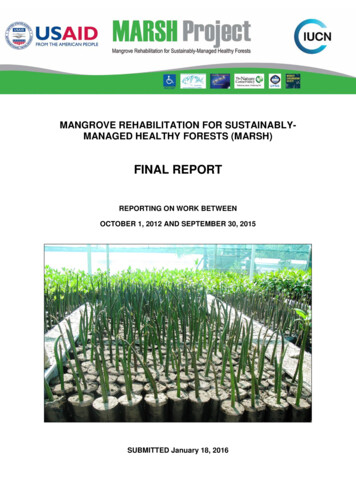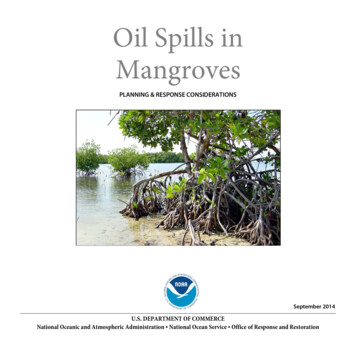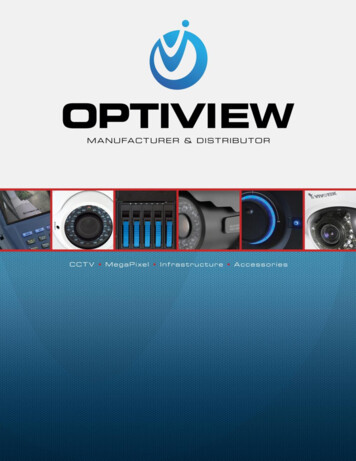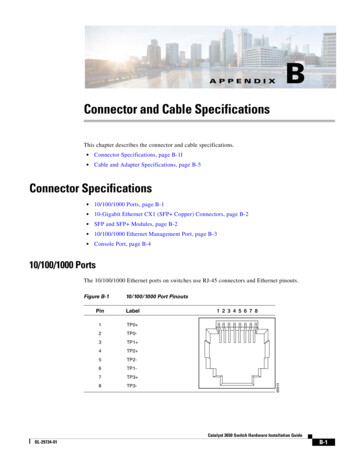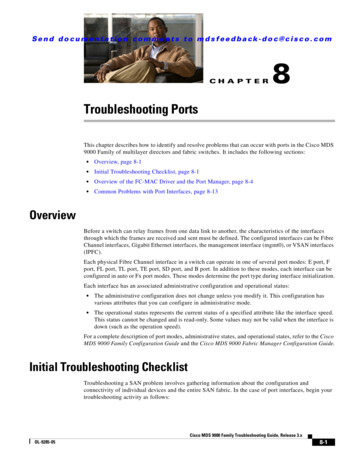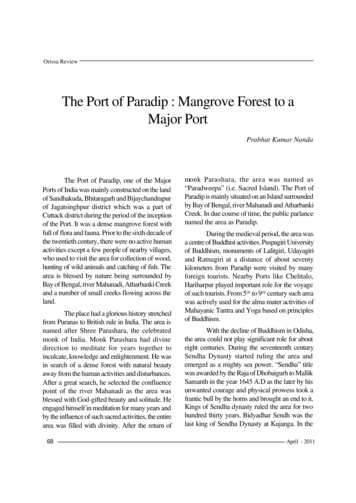
Transcription
Orissa ReviewThe Port of Paradip : Mangrove Forest to aMajor PortPrabhat Kumar NandaThe Port of Paradip, one of the MajorPorts of India was mainly constructed on the landof Sandhakuda, Bhitaragarh and Bijaychandrapurof Jagatsinghpur district which was a part ofCuttack district during the period of the inceptionof the Port. It was a dense mangrove forest withfull of flora and fauna. Prior to the sixth decade ofthe twentieth century, there were no active humanactivities except a few people of nearby villages,who used to visit the area for collection of wood,hunting of wild animals and catching of fish. Thearea is blessed by nature being surrounded byBay of Bengal, river Mahanadi, Atharbanki Creekand a number of small creeks flowing across theland.The place had a glorious history stretchedfrom Puranas to British rule in India. The area isnamed after Shree Parashara, the celebratedmonk of India. Monk Parashara had divinedirection to meditate for years together toinculcate, knowledge and enlightenment. He wasin search of a dense forest with natural beautyaway from the human activities and disturbances.After a great search, he selected the confluencepoint of the river Mahanadi as the area wasblessed with God-gifted beauty and solitude. Heengaged himself in meditation for many years andby the influence of such sacred activities, the entirearea was filled with divinity. After the return of68monk Parashara, the area was named as“Paradweepa” (i.e. Sacred Island). The Port ofParadip is mainly situated on an Island surroundedby Bay of Bengal, river Mahanadi and AtharbankiCreek. In due course of time, the public parlancenamed the area as Paradip.During the medieval period, the area wasa centre of Buddhist activities. Puspagiri Universityof Buddhism, monuments of Lalitgiri, Udayagiriand Ratnagiri at a distance of about seventykilometers from Paradip were visited by manyforeign tourists. Nearby Ports like Chelitalo,Hariharpur played important role for the voyageof such tourists. From 5th to 9 th century such areawas actively used for the alma mater activities ofMahayanic Tantra and Yoga based on principlesof Buddhism.With the decline of Buddhism in Odisha,the area could not play significant role for abouteight centuries. During the seventeenth centurySendha Dynasty started ruling the area andemerged as a mighty sea power. “Sendha” titlewas awarded by the Raja of Dhobaigurh to MallikSamanth in the year 1645 A.D as the later by hisunwanted courage and physical prowess took afrantic bull by the horns and brought an end to it.Kings of Sendha dynasty ruled the area for twohundred thirty years. Bidyadhar Sendh was thelast king of Sendha Dynasty at Kujanga. In theApril - 2011
Orissa Reviewyear 1876, Burdhwan Maharaja took thepossession of Kujang and the administration ofthe area was taken over by the Anchal Adhikari,Government of Orissa in the year 1952.Maritime activities around Paradip wasrecorded in history during the period 1600 to1800 A.D. The Port of Hariharpur rose toeminence as an effective Port and boat buildingcentre. Later Batighar and Hukitola were Portsof operation used by French, Portuguese andEnglish Traders. Batighar, popularly known asFalse Point Light House is about one and halfcentury old. Such Port was used mainly for exportof rice and spices. The historical Light House nearthe Port have been serving mariners of east-coastby disseminating marine signals for safe voyage.Hukitola was a prominent Port for small vesselsand anchorage point for big vessels. The WareHouse constructed one hundred years ago, is noweven present in dilapidated condition.Both Batighar and Hukitola wereabandoned for trade for political and economicreasons. The historical light house at Batighar(False Point Light House) is still in operation,flashing during night, breaking the solitude ofMahanadi estuary and Bay of Bengal.In 1948 the Port (Technical) Committeeformed by Government of India felt the necessityof a Port between Visakhapatnam and Calcutta.After the independence, Port of Dhaka wasseparated from the maritime map of India and tocompensate such loss, it was required for anotherPort on the east coast.Central Water & Power Commissionwas requested by Government of Orissa toexplore the possibility of commissioning a Port inthe Mahanadi river delta. CWPC recommendedfor a Port at Paradip on Mahanadi river in theyear 1950. A group of consulting engineers ofFrance were engaged by the Government of IndiaApril - 2011in 1951 to offer advice for a particular site for thePort in the delta of the Devi, Mahanadi andDhamra rivers.French Mission suggested theconstruction of Port at the mouth of the Mahanadiriver. As per their suggestion the Port facilitiesshould be located within the estuary with anapproach channel dredged through the bar andprotected by breakwaters. Study was alsoconducted by Indian Navy in the year 1951 forthe movement of vessels from sea to Paradip Portand observed that there was no hindrance toshipping to the Port of Paradip. Central Waterand Power Research Station, Pune conducted amodel study during 1954 to prefer between twoalternatives viz. an estuarine harbour and a coastalharbour. Such study continued upto 1958 andrecommended for a lagoon type harbour.Meanwhile during 1956, Mr.I.G. Chacke,Officer-on-Special Duty (Minor Ports) studiedthe feasibility of investment of funds for thedevelopment of Paradip Port under Second FiveYear Plan. He suggested to declare Paradip asminor Port. In the same year, Kinoshitra &Company of Japan after detail study throughTokyo University recommended for the harbourjust south of the Mahanadi.In 1958, the Intermediate PortDevelopment Committee of Government of Indiaaccepted the report of Mr.Chacke and Paradipwas declared as a Minor Port. Port of Paradipstarted as a fair weather anchorage Port forexport of Iron Ore through lighters to take IronOre to the Ship at the anchorage. During suchperiod, Chaumuhani at a distance of about 15kilometers from Paradip was the centre oftransportation of Iron ore through barges. IronOre transported by big boats from the mines headand brought to Chaumuhani by Taladanda Canal.Iron Ore were further transported to the anchoragepoint of Bay of Bengal for loading in ships for69
Orissa Reviewshipment to different Ports of Japan. Thereminiscences of damaged barges named asGajaraja, Kites etc are now even visualized atChaumuhani.M/s.Rendel, Palmer & Tritton, aconsulting engineering firm of United Kingdom,popularly known as ‘RPT’ recommended for alagoon type deep water Port at Paradip. Afterone year study, report was submitted in June,1962 and Government of Orissa started theconstruction work on the 15th March, 1964.The 3rd January, 1962 is a red-letter dayin the history of Paradip Port. Pandit JawaharlalNehru, the first Prime Minister of independentIndia laid the foundation stone of the Port anddedicated the endeavour to the people of Indiawith following enunciation “Willed by the people,I commend you, to this another NationalAdventure”. The foundation stone with the aboveenunciation in Odia, Hindi and English was laidbeing prepared in the black granite stone. Oncareful analysis, it is observed that the writing ofthe text on the foundation stone was a departurefrom the prevalent style of writing of foundationstone. Usually in every foundation stone the nameof the person laying the foundation stone and thename of the project/industry etc along with thechief guest are engraved/painted on the stone. Thefoundation stone now displayed in front of theJawahar Guest House depicts only the saying ofPt.Jawaharlal Nehru and the date of the function.Like that of conventional writing on foundationstones, there are no mention of the dignitariespresent during the function. It is analysed that whenBiju Pattnaik requested Pt.Nehru for laying of thefoundation stone, Pt.Nehru was not sure aboutthe completion of the Paradip Port Project.Hence, instead of normal writing on the foundationstone i.e. the name of the inaugurator, the projectand the date of inauguration etc with dignitaries70present during the ceremony, he only preferredfor a statement as a message to the nation.Dignitaries like Biju Pattnaik, the thenChief Minister of Orissa, Sri Y.M.Sukthankar, thethen Governor of Orissa, Sri Nilamani Routray,the then Minister of Commerce and NilakanthaMishra, Chief Engineer of the project werepresent in the ceremony but their names were notrecorded in the foundation stone.As per the request of Government ofOrissa, Government of India took over themanagement of Port from Government of Orissaon 1st June, 1965. Later Paradip Port establishedthe firm position in the maritime map of India as aMajor Port on the 8th April, 1966. The first TrustBoard was formed on 1st November, 1967. ThePort which was commissioned for export of IronOre to Japan, was later developed as a multi cargoPort. The Port commissioned with the single berthfor handling of Iron Ore has added 14 more berthsin her lap by the 1st decade of 21st Century. ThePort which was started in the year 1966 with thehandling of cargo within few thousand tones ofiron ore, has achieved the glory of handling morethan 50 million tonnes of cargo during the 1s tdecade of 21st Century and the Port has also setthe target of handling more than 100 million tonnesof cargo by the end of 2 nd decade of 21st Centurypromising to be the main commercial hub ofEastern India.LOCATION:Paradip Port is situated 210 nautical milessouth of Kolkata and 260 nautical miles north ofVisakhapatnam at Latitude 20 - 15'-55.44" Nand Longitude 86 -40'-34.62" E. It is strategicallysituated so as to serve a vast hinterland spreadingover the States of Orissa, Jharkhand,Chhattisgarh, Madhya Pradesh, Uttar Pradesh,Bihar and West Bengal.April - 2011
Orissa ReviewCARGO PROFILE:Initially port was started as amonocommodity port to handle iron ore only.There was no rail connectivity to this port fortransportation of cargo from hinterland. The portwas only connected by an “Express Highway”presently known as National Highway- 5A toDaitari Mines. The Iron ore was transported byMitsubishi Bottom Dump Trucks and was storedin a twin stackyard. All the activities for cargohandling at the port were carried out manually.The Port could be able to handle eighty-four (84)numbers of vessels with traffic of 67080 metrictonnes during 1966-67.After nine years, Paradip Port diversifiedits cargo profile by constructing new facilities. Inthe year 1975, the first general cargo berth nowknown as EQ-1 was commissioned for handlingof care foods, sugar, wheat, and other generalcargoes. Afterward, Paradip Port aggressivelycontinued to augment its capacity by constructingnew berths and procuring new state-of-artequipment in order to bridge supply-demand gap.As a result, the traffic of the port started exhibitingupward surge leveraging on its competitiveadvantage over other ports and locationaladvantages. The installed capacity in million metrictonne (MMT) vis-à-vis the cargo handled for lastthirteen years is charted out in the Exhibit 1.Major Ports in terms of volume of traffic handled.The traffic handled at this port during the last sixyears has more than doubled. The principalcommodity-wise cargo handled during 2009-10compared to 2008-09 is indicated at Table 1.The growth of traffic at the Port since inceptionover years is charted out in the Exhibit 2. Thecharts showing the cargo handling trends forprincipal commodities like Iron Ore, ThermalCoal, Coking Coal and POL & Crude are shownin the Exhibit 3.At present, the Port is equipped with eightgeneral cargo berths, two mechanised coalhandling berths, one mechanised iron ore handlingberth, one oil berth, one single point mooring(SPM), one Ro-Ro Jetty apart from two captiveberths for PPL and IFFCO to serve the maritimeindustry by handling dry bulk, break bulk, liquidbulk, project and over dimensional cargoes aswell as containers. Now port is capable ofhandling almost all types of cargoes like iron ore,thermal coal, coking coal, chrome ore, manganeseore, charge chrome, ferro chrome, ferromanganese, limestone, hard coke, ingots andmoulds, billets, finished steel, scrap, fertilizer,clinker, gypsum, project cargo, containers, cleancargo, POL and crude oil.Paradip Port handled an all-time recordtraffic of 57.01 MMT during the year 2009-10surpassing the previous year record of 46.41MMT handled during 2008-09 registering agrowth of 22.84% over the previous year.Paradip Port achieved the highest growth rate intraffic handling amongst all the Major Ports duringthe year 2009-10 beating the competition and slowExport/Import business in international market.Paradip Port’s position had improved to 5t hposition from earlier 8th position amongst theApril - 201171
003-04P.O.L.Iron oreThermal coalCoking coalOther 998-992000-012002-032004-052006-072008-09Orissa ReviewExhibit-1Table-1Principal Commodity-wise traffic handled in MMT% Variation259.5713.240.81(-) 8.427.3222.84TOTAL CARGO HANDLED ( IN MMT)50403020100I.ORE ( IN MMT)201612840April - 2011
9-10Orissa ReviewTHERMAL COAL (IN MMT)1614121086420April - 201173
Orissa ReviewPOL (IN 92009-100Exhibit - 3CARGO PROFILE DYNAMICSDuring initial four years of operation as amono-commodity Port (1966-70), share of ironore in the total traffic handled was 95%. Duringthe next decades, share of iron ore in total traffichandled reduced to 80% (1970-80), 46% (198090), 14% (1990-2000), and 27% (2000-2010)due to diversification of cargo profile in the Port.Shares of iron ore, chrome ore, POL & crudeoil, thermal coal, coking coal and other cargosare 29%, 2%, 7%, 33%, 11%, and 18%respectively in the total traffic handled up to 31/03/2010 (505.28MMT) since inception of thePort. The profiles of cargo handled during the fivedecades along with the cargo composition in thetotal traffic handled during the entire operationallife of the Port (1966-2010) are as follows:(i) CARGO PROFILE DURING 1966-70 (IN MMT)WHEAT, 0.02,1%Others, 0.0615,2%CH.ORE, 0.0693, 2%I.ORE, 3.809, 95%74April - 2011
Orissa ReviewCURRENT TRENDThe traffic growth of PPT in recent yearsmay be analysed in two phases viz, Phase I (19962003) and Phase II (2003-2010). During PhaseI, PPT grew at a CAGR of 13% and in Phase II,PPT demonstrated a healthy CAGR of more than15%. An interesting trend which could beobserved in the last ten years is that the share ofoverseas cargo (Import and Export) grew from50% in 2001 to 78% in 2010. The main exportdestination was China which attracted around60% of total exported cargo in 2010.(vi) CARGO PROFILE DURING 1966-2010 (IN MMT)During the last ten years, the share of ironore in the total traffic has almost doubled from15% to 28%. The imported coal share grew from8% in 2001 to 17% in 2010 and the export coalshare dropped from 41% to 17% during theperiod. The major drive for last years growth wasimported cargo which grew by 47% to 29.18MMT from 19.88 MMT.Countries of Export cargoes destinationand Import cargoes origin, principal commoditywise, are presented in the Table – 3.April - 201175
Orissa ReviewTable – 3Export CargoCommodityDestinationImport CargoCommodityOriginIron OreChinaCrude OilAlgeria, Brunei, Iraq, Nigeria,Kuwait, UAECh. OreChina, Japan, SouthKoreaPOL (HSD, SKO) Coastal (India), SingaporeT. CoalCoastal (India)C. CoalAustralia, New Zealand, Indonesia,SingaporePOL (HSD,SKO)CoastalN.C.CoalIndonesia, South Africa, AustraliaContainerSingapore, Myanmar,Malaysia, ChinaFertiliserIndonesia, South Arabia, China.FRM (Dry)Jordan, Morocco, Vietnam, UAE,Iran, Qatar, Russia, UkraineProject materialsChina, Germany, UAE, Belgium,South KoreaFUTURE ROAD MAP:The State of Orissa is considered as theprimary hinterland of Paradip Port. Orissa is richin mineral reserves having 183 MMT of Chromite(98% of total reserve in India), 440 MMT ofNickel (95% of total reserve in India), 1743 MMTof Bauxite (60% of total reserve in India), 5428MMT of Iron Ore (26% of total reserve in India),and 61999 MMT of Coal (24% of total reservein India). Apart from other hinterland, the capexfor total projects under implementation in Orissaonly and annual average growth rate of exportfrom Orissa as on 01/01/2010 is pegged at ‘ 3240billion and 33% respectively. About 49 nos. ofSteel Plants of 83MMTPA total capacity, 4aluminium complexes with more than 4 MMTPAcapacity and 1MMTPA aluminium smelter, 27nos.of Thermal Power Plants of 32000MW76generation capacity, 15MMTPA megapetrochemical complex by IOC and megaPetroleum, Chemical and PetrochemicalsInvestment Region (PCPIR) at Paradip are someof the major projects coming up in Orissa.Paradip Port is set to play the role of key memberin the supply chain as maritime gateway for importof project materials & input materials and exportof finished products. Apart from the opportunitiesin the primary hinterland, the secondaryhinterlands (Bihar, Jharkhand, Andhrapradesh,Chhattisgarh, WB) also provide immenseuntapped business prospects for Paradip Port Asa proactive action, Paradip Port is presentlyundertaking major expansion projects likeconstruction of deep draught Iron Ore & CoalTerminals, construction of multipurpose berth,April - 2011
Orissa Reviewinstallation of Single Point Moorings, constructionof RO-RO jetty, and deepening of channels andberth face dredging. The cargo forecast up to theyear 2015 – 16 and the major upcoming projectshave been indicated in Table – 3 and Table – 4respectively.TABLE – 3: CARGO FORECASTYearPOLIron .0016.0096.00TABLE – 4: CAPACITY EXPANSION PROJECTSName of PlanCapacityAdditionYear ofCompletionPresentCapacity ofPortTotalProjectedCapacityDeepening of Channel and berths.MTPA5.00 MTPA201176.00 MTPA157.00Mechanization of CQ-III.4.00 MTPA2011Installation of second SPM byIOCL.11.00 MTPA 2013Development of new deep draughtIron Ore berth on BOT basis.10.00 MTPA 2013Development of new deep draughtCoal berth on BOT basis.10.00 MTPA 2013Construction of one no. of Oil berth. 10.00 MTPA 2013Installation of 3rd SPM by IOCL11.00 MTPA 2014Construction of one no. ofMultipurpose berth.5.00 MTPA2014Development of Western dock.15.00MTPA2015TOTAL81.00 MTPAApril - 201177
Orissa ReviewCONCLUSIONLeveraging on core strengths, i.e, deepdraft, proximity to mineral reserves, vicinity to thelarge land-locked hinterland, Paradip Port has thepotential to become the economic thrust enginefor Eastern India by serving the State as well asNation through world-class services. DelayedStatutory clearances, Long decision makingprocesses, land expansion constraints, andconnectivity to land side for seamless cargoevacuation are the key challenges for the Port tobe competitive and reactive to market demands.The Port has already developed its corecompetence in handling Bulk and Break-bulkcargo. Though the major share of total traffic beinghandled at present is Bulk and Break-bulk cargo,the Port is striving hard to become the hub port inthe Eastern India by diversifying its cargo profilefurther. As the first step, the Port has decided toconstruct a Multipurpose berth of 5 MMTPAcapacity on BOT basis to handle clean cargoincluding containers. After commissioning of themultipurpose berth, mega petrochemical complexby IOC and mega PCPIR at Paradip, the cargoprofile of the traffic at Paradip Port may witnessa change.Prabhat Kumar Nanda is the Secretary of Paradip PortTrust.Hon'ble Chief Minister Shri Naveen Patnaik giving award to Padmini Rout at theBiju Patnaik Award Giving Ceremony -2011 at Jaydev Bhawan on 5.3.2011.Shri Prabin Chandra Bhanj Deo, Minister for Sports & Youth Services andDr. Prasanna Kumar Patasani, M.P. are also present.78April - 2011
the firm position in the maritime map of India as a Major Port on the 8 th April, 1966. The first Trust Board was formed on 1st November, 1967. The Port which was commissioned for export of Iron Ore to Japan, was later developed as a multi cargo Port. The Port commissioned with the single berth for handling of Iron Ore has added 14 more berths

